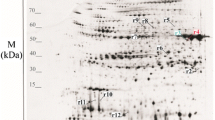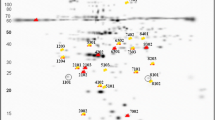Abstract
Tomato production has been severely affected by root-knot nematode (RKN) diseases, leading to huge economic losses in tomato cultivation, production, and processing. To gain insight into the signal mechanism of resistance to RKN (Meloidogyne incongnita), tomato lines with different endogenous jasmonic acid levels were inoculated with RKN, and the differential proteome of their phloem was analyzed with two-dimensional gel electrophoresis. Analysis of 1400 protein spots from each gel revealed 74 differentially expressed proteins, 30 of which were identifed via matrix-assisted laser-desorption ionization time-of-flight mass spectrometry (MALDI-TOF–MS). Among these 30, the abundance of 25 proteins was elevated in 35S::PS, and five proteins were not expressed in spr2. The total differentially expressed proteins were grouped into multiple functional categories, the largest of which was energy conversion (38 %). Furthermore, we proposed several candidates that might function as potential signal molecules under RKN stress and dissected the multiple roles of proteins related to photosynthesis and energy conversion. The mRNA levels of nine proteins associated with defense responses and energy metabolism were analyzed by qRT-PCR, and the expression levels of five were in line with the proteome data.




Similar content being viewed by others
References
Afzal AJ, Natarajan A, Saini N, Iqbal MJ, Geisler M, El Shemy HA, Mungur R, Willmitzer L, Lightfoot DA (2009) The nematode resistance allele at the rhg1 locus alters the proteome and primary metabolism of soybean roots. Plant Physiol 151:1264–1280
Bradford MM (1976) A rapid and sensitive method for the quantitation of microgram quantities of protein utilizing the principle of protein-dye binding. Anal Biochem 72:248–254
Callahan FE, Jenkins JN, Creech RG, Lawrence GW (1997) Changes in cotton root proteins correlated with resistance to root knot nematode development. J Cotton Sci 1:38–47
Carlson M (1998) Regulation of glucose utilization in yeast. Curr Opin Genet Dev 8:560–564
Cooper WR, Jia L, Goggin L (2005) Effects of jasmonate-induced defenses on root-knot nematode infection of resistant and susceptible tomato cultivars. J Chem Ecol 31:1953–1967
Curtis D, Lehmann R, Zamore PD (1995) Translational regulation in development. Cell 81:171–178
de Moor C, Richter JD (2001) Translational control in vertbrate development. In: Etkin LD, Jeon KW (eds) Cell lineage specification and patterning of the embryo. Academic Press, San Diego, pp 567–608
Ding CK, Wang C, Gross KC, David LS (2002) Jasmonate and salicylate induce the expression of pathogenesis-related-protein genes and increase resistance to chilling injury in tomato fruit. Planta 214(6):895–901
Dropkin VH (1969) Cellular responses of plants to nematode infections. Annu Rev Phytopathol 7:101–122
Epstein PN, Boschero AC, Atwater I, Cai X, Overbeek PA (1992) Expression of yeast hexokinase in pancreatic β cells of transgenic mice reduces blood glucose, enhances insulin secretion, and decreases diabetes. Proc Natl Acad Sci USA 89:12038–12042
Fan JW, Hu CL, Zhang LN, Li ZL, Zhao FK, Wang SH (2015) Jasmonic acid mediates tomato’s response to root knot nematodes. J Plant Growth Regul 34:196–205
Faurobert M, Pelpoir E, Chab J (2007) Phenol extraction of proteins for proteomic studies of recalcitrant plant tissues. Methods Mol Biol 355:9–14
Fedoroff NV (2002) RNA-binding proteins in plants: the tip of an iceberg? Curr Opin Plant Biol 5:452–459
Förster B, Mathesius U, Pogson BJ (2006) Comparative proteomics of high light stress in the model alga Chlamydomonas reinhardtii. Proteomics 6:4309–4320
Fujimoto T, Tomitakab Y, Abec H, Tsudab S, Futaia K, Mizukubob T (2011) Expression profile of jasmonic acid-induced genes and the induced resistance against the root-knot nematode (Meloidogyne incognita) in tomato plants (Solanum lycopersicum) after foliar treatment with methyl jasmonate. J Plant Physiol 168:1084–1097
Gancedo JM (1998) Yeast carbon catabolite repression. Microbiol Mol Biol Rev 62:334–361
Gómez-Ariza J, Campo S, Rufat M, Estopà M, Messeguer J, San Segundo B, Coca M (2007) Sucrose-mediated priming of plant defense responses and broad-spectrum disease resistance by overexpression of the maize pathogenesis-related PRms protein in rice plants. Mole Plant-Microbe In 20(7):832–842
Grupe A, Hultgren B, Ryan A, Ma YH, Bauer M, Stewart TA (1995) Transgenic knockouts reveal a critical requirement for pancreatic β cell glucokinase in maintaining glucose homeostasis. Cell 83:69–78
Gupta AK, Kaur N (2005) Sugar signalling and gene expression in relation to carbohydrate metabolism under abiotic stresses in plants. J Biosci 30:761–776
Hammond-Kosack KE, Atkinson HJ, Bowles DJ (1990) Changes in abundance of translatable mRNA species in potato roots and leaves following root invasion by cyst-nematode G, rostochiensis pathotypes. Physiol Mol Plant Pathol 37:339–354
Heil M, Ton J (2008) Long-distance signalling in plant defence. Trends Plant Sci 13:264–272
Herbers K, Meuwly P, Frommer WB, Metraux JP, Sonnewald U (1996) Systemic acquired resistance mediated by the ectopic expression of invertase: possible hexose sensing in the secretory pathway. Plant Cell 8:793–803
Jarsch IK, Ott T (2011) Perspectives on remorin proteins, membrane rafts, and their role during plant–microbe interactions. Mol Plant Microbe Interact 24:7–12
Jensen RG (2000) Activation of Rubisco regulates photosynthesis at high temperature and CO2. Proc Natl Acad Sci USA 97:12937–12938
Johnston M (1999) Feasting, fasting and fermenting: glucose sensing in yeast and other cells. Trends Genet 15:29–33
Johnstone O, Lasko P (2001) Translational regulation and RNA localization in Drosophila oocytes and embryos. Annu Rev Genet 35:365–406
Jorge I, Navarro RM, Lenz C, Ariza D, Porras C, Jorrín J (2005) The Holm Oak leaf proteome: analytical and biological variability in the protein expression level assessed by 2-DE and protein identification tandem mass spectrometry de novo sequencing and sequence similarity searching. Proteomics 5:222–234
Katayama H, Nagasu T, Oda Y (2001) Improvement of in-gel digestion protocol for peptide mass fingerprinting by matrix-assisted laser desorption/ionization time-of-flight mass spectrometry. Rapid Commun Mass Spectrom 15:1416–1421
Lee MO, Kim KP, Kim B, Hahn JS, Hong CB (2009) Flooding stress-induced glycine-rich RNA-binding protein from Nicotiana tabacum. Mol Cells 27:47–54
León J (2013) Role of plant peroxisomes in the production of jasmonic acid-based signals. Subcell Biochem 69:299–313
Li C, Liu G, Xu C, Lee GI, Bauer P, Ling HQ, Ganal MW, Howe GA (2003) The tomato suppressor of prosystemin-mediated responses2 gene encodes a fatty acid desaturase required for the biosynthesis of jasmonic acid and the production of a systemic wound signal for defense gene expression. Plant Cell 15:1646–1661
Lough TJ, Lucas WJ (2006) Integrative plant biology: role of phloem long-distance macromolecular trafficking. Annu Rev Plant Biol 57:203–232
Maris C, Dominguez C, Allain FHT (2005) The RNA recognition motif, a plastic RNA-binding platform to regulate post-transcriptional gene expression. FEBS J 272:2118–2131
McGurl B, Ryan CA (1992) The organization of the prosystemin gene. Plant Mol Biol 20:405–409
Moeder W, Del Pozo O, Navarre DA, Martin GB (2007) Plant aconitase functions as an RNA2-binding protein and plays a role in regulating resistance to oxidative stress and hypersensitive cell death. Plant Mol Biol 63:273–287
Nahar K, Kyndt T, De Vleesschauwer D, Höfte M, Gheysen G (2011) The jasmonate pathway is a key player in systemically induced defense against root knot nematodes in rice. Plant Physiol 157:305–316
Pérez-Bueno ML, Rahoutei J, Sajnani C, García-Luque I, Barón M (2004) Proteomic analysis of the oxygen-evolving complex of photosystem II under biotec stress: studies on Nicotiana benthamiana infected with tobamoviruses. Proteomics 4:418–425
Popova LP, Stanka GV (1988) Effect of jasmonic acid on the synthesis of ribulose-1, 5-bisphosphate carboxylase-oxygenase in barley leaves. J Plant Physiol 133:210–215
Popova LP, Tsonev TD, Vaklinova SG (1988) Changes in some photosynthetic and photorespiratory properties in barley leaves after treatment with jasmonic acid. J Plant Physiol 132:257–261
Raffaele S, Bayer E, Lafarge D, Cluzet S, ReS German, Boubekeur T, Leborgne-Castel N, Carde JP, Lherminier J, Noirot E, Satiat-Jeunemaître B, Laroche-Traineau J, Moreau P, Ott T, Maule AJ, Reymond P, Simon-Plas F, Farmer EE, Bessoule JJ, Mongrand S (2009) Remorin, a Solanaceae protein resident in membrane rafts and plasmodesmata, impairs Potato virus X movement. Plant Cell 21:1541–1555
Rakwal R, Komatsu S (2001) Jasmonic acid-induced necrosis and drastic decreases in ribulose-1, 5-bisphosphate carboxylase/oxygenase in rice seedlings under light involves reactive oxygen species. J Plant Physiol 58:679–688
Roitsch T (1999) Source-sink regulation by sugar and stress. Curr Opin Plant Biol 2:198–206
Salzman RA, Tikhonova I, Bordelon BP, Hasegawa PM, Bressan RA (1998) Coordinate accumulation of antifungal proteins and hexoses constitutes a developmentally controlled defense response during fruit ripening in grape. Plant Physiol 117:465–472
Schilmiller AL, Howe GA (2005) Systemic signaling in the wound response. Curr Opin Plant
Sugihara K, Hanagata N, Dubinsky Z, Baba S, Karube I (2000) Molecular characterization of cDNA encoding oxygen evolving enhancer protein 1 increased by salt treatment in the mangrove Bruguiera gymnorrhiza. Plant Cell Physiol 41:1279–1285
Thorpe MR, Ferrieri AP, Herth MM, Ferrieri RA (2007) 11C-imaging: methyl jasmonate moves in both phloem and xylem, promotes transport of jasmonate, and of photoassimilate even after proton transport is decoupled. Planta 226:541–551
Truman W, Bennett MH, Kubigsteltig I, Turnbull C, Grant M (2007) Arabidopsis systemic immunity uses conserved defense signaling pathways and is mediated by jasmonates. Proc Natl Acad Sci USA 104:1075–1080
Wickens M, Bernstein D, Crittenden S, Luitjens C, Kimble J (2001) PUF proteins and 3′UTR regulation in the Caenorhabditis elegans germ line. Cold Spring Harb Symp Quant Biol 66:337–343
Yang EJ, Oh YA, Lee ES, Park AR, Cho SK, Yoo YJ, Park OK (2003) Oxygen-evolving enhancer protein 2 is phosphorylated by glycine-rich protein 3/wall-associated kinase 1 in Arabidopsis. Biochem Biophys Res Commun 305:862–868
Zhang L, Xing D (2008) Methyl jasmonate induces production of reactive oxygen species and alterations in mitochondrial dynamics that precede photosynthetic dysfunction and subsequent cell death. Plant Cell Physiol 49(7):1092–1111
Zhao WC, Li ZL, Fan JW, Hu CL, Yang R, Qi X, Chne H, ZhaoFK Wang SH (2015) Identification of jasmonic acid-associated microRNAs and characterization of the regulatory roles of the miR319/TCP4 module under root-knot nematode stress in tomato. J Exp Bot 66:4653–4667
Zhuang WB, Shi T, Gao ZH, Zhang Z, Zhang JY (2013) Differential expression of proteins associated with seasonal bud dormancy at four critical stages in Japanese apricot. Plant Biol 15(233–242):20
Acknowledgments
CM, spr2, and 35S::PS seeds were donated by Prof. Chuanyou Li from the Institute of Genetics and Developmental Biology, Chinese Academy of Sciences. This work was supported by the Project of Great Wall Scholar, Beijing Municipal Commission of Education (CIT&TCD20130323) and the Modern Agricultural Industry Technology System of Beijing Innovation Team (BAIC01-2016).
Author information
Authors and Affiliations
Corresponding author
Electronic supplementary material
Below is the link to the electronic supplementary material.
Rights and permissions
About this article
Cite this article
Zhao, W., Hao, J., Xing, J. et al. Proteomic Analysis of Phloem Proteins Leads to the Identification of Potential Candidates for JA-Mediated RKN-Resistant Elements in Solanum lycopersicum . J Plant Growth Regul 36, 96–105 (2017). https://doi.org/10.1007/s00344-016-9622-1
Received:
Accepted:
Published:
Issue Date:
DOI: https://doi.org/10.1007/s00344-016-9622-1




